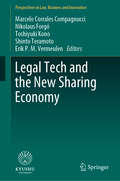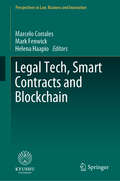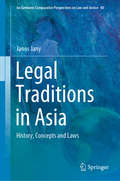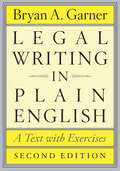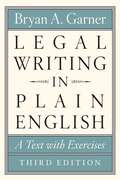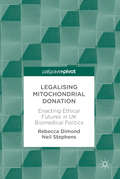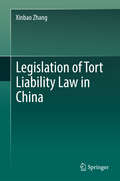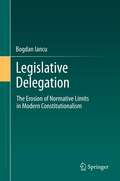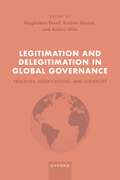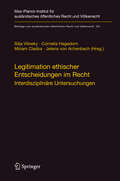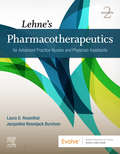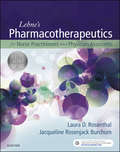- Table View
- List View
Legal Signs Fascinate: Kevelson's Research on Semiotics (SpringerBriefs in Law)
by Jan M. Broekman Frank FleerackersThis engaging book examines the origins and first effects of the concept ‘legal semiotics’, focusing on the inventor of the term, Roberta Kevelson (1931-1998). It highlights the importance of her ideas and works which have contributed to legal theory, legal interpretation and philosophy of language. Kevelson’s work is particularly relevant today, in our world of global electronic communication networks which rely so much on language, signs, signals and shortcuts. Kevelson could not have foreseen the 21st century, yet the story of her work and influence deserves more attention as it is key to our understanding of modern legal discourse and why law fascinates and is accepted in modern society. The authors draw on Kevelson’s hitherto unknown Office Papers and Notes, and a biographical examination points to key influences in her work such as the early feminist movements of the US East Coast, the philosophy of Charles Sanders Peirce and the semiotics of Thomas Sebeok. This forms the basis for a more encompassing research of Kevelson’s position, work and philosophical background, which the authors call for. A quick and enlightening read, this book interests a wide range of readers with an interest in legal history and the fields which Kevelson both drew on and influenced, including lawyers, students and scholars.
Legal Spaces: Towards a Topological Thinking of Law
by Sabine Müller-MallThis book is concerned with a central question in contemporary legal theory: how to describe global law? In addressing this question, the book brings together two features that are different and yet connected to one another: the conceptual description of contemporary law on the one hand, and methods of taking concrete perspectives on law on the other hand. The book provides a useful concept for describing global law: thinking of law spatially. It illustrates that space is a concept with the capacity to capture the relationality, dynamics, and hybridity of law. Moreover, this book investigates the role of topological thinking in finding concrete perspectives on law. Legal Spaces offers an innovative and interdisciplinary approach to law.
Legal Tech and the New Sharing Economy (Perspectives in Law, Business and Innovation)
by Toshiyuki Kono Nikolaus Forgó Marcelo Corrales Compagnucci Shinto Teramoto Erik P. M. VermeulenThe exponential growth of disruptive technology is changing our world. The development of cloud computing, big data, the internet of things, artificial intelligence, machine learning, deep learning, and other related autonomous systems, such as self-driving vehicles, have triggered the emergence of new products and services. These significant technological breakthroughs have opened the door to new economic models such as the sharing and platform-based economy. As a result, companies are becoming increasingly data- and algorithm-driven, coming to be more like “decentralized platforms”. New transaction or payment methods such as Bitcoin and Ethereum, based on trust-building systems using Blockchain, smart contracts, and other distributed ledger technology, also constitute an essential part of this new economic model. The sharing economy and digital platforms also include the everyday exchange of goods allowing individuals to commodify their surplus resources. Information and innovation technologies are used in order to then match these resources with existing demand in the market. Online platforms such as Airbnb, Uber, and Amazon reduce information asymmetry, increase the value of unused resources, and create new opportunities for collaboration and innovation. Moreover, the sharing economy is playing a major role in the transition from exclusive ownership of personal assets toward access-based exploitation of resources. The success of online matching platforms depends not only on the reduction of search costs but also on the trustworthiness of platform operators. From a legal perspective, the uncertainties triggered by the emergence of a new digital reality are particularly urgent. How should these tendencies be reflected in legal systems in each jurisdiction? This book collects a series of contributions by leading scholars in the newly emerging fields of sharing economy and Legal Tech. The aim of the book is to enrich legal debates on the social, economic, and political meaning of these cutting-edge technologies. The chapters presented in this edition attempt to answer some of these lingering questions from the perspective of diverse legal backgrounds.
Legal Tech, Smart Contracts and Blockchain (Perspectives in Law, Business and Innovation)
by Marcelo Corrales Mark Fenwick Helena HaapioThere is a broad consensus amongst law firms and in-house legal departments that next generation “Legal Tech” – particularly in the form of Blockchain-based technologies and Smart Contracts – will have a profound impact on the future operations of all legal service providers. Legal Tech startups are already revolutionizing the legal industry by increasing the speed and efficiency of traditional legal services or replacing them altogether with new technologies. This on-going process of disruption within the legal profession offers significant opportunities for all business. However, it also poses a number of challenges for practitioners, trade associations, technology vendors, and regulators who often struggle to keep up with the technologies, resulting in a widening regulatory “gap.” Many uncertainties remain regarding the scope, direction, and effects of these new technologies and their integration with existing practices and legacy systems. Adding to the challenges is the growing need for easy-to-use contracting solutions, on the one hand, and for protecting the users of such solutions, on the other. To respond to the challenges and to provide better legal communications, systems, and services Legal Tech scholars and practitioners have found allies in the emerging field of Legal Design. This collection brings together leading scholars and practitioners working on these issues from diverse jurisdictions. The aim is to introduce Blockchain and Smart Contract technologies, and to examine their on-going impact on the legal profession, business and regulators.
Legal Theory (Macmillan Law Masters)
by Ian McLeodWhy do some rules have the status of law while others do not? Is law simply a matter of rules anyway? What is justice? Is there a duty to obey a law even if it is unjust? Should the law concern itself with the activities of consenting adults in private? Legal Theory asks questions such as these and explains some of the answers which legal theorists have given from Ancient Greece to the present day. Written in a very readable style, this book makes intrinsically difficult material accessible and interesting.
Legal Thoughts Convert: Rethinking Legal Thinking (SpringerBriefs in Law)
by Jan M. Broekman Frank FleerackersThis book highlights how conversion via communication is one of the most important issues in legal thinking. A major aspect is its link with language – legal texts, judgments, opinions and legal concepts included. Further, conversion is connected to all social positions in law. But a jurist will not solely master specific social behaviors or become the manager of large-scale political fields of law as a legal scientist. A continuously changing integration opens up to his views on reality as it presents itself incessantly. Law and its functionaries are in a never-ending process of change in all domains of culture, which mark the 21st century. Conversions thus concern the riddle of wisdom and automatism, of individual privacy and social fixations, of philosophical considerations and converting flows.
Legal Traditions in Asia: History, Concepts and Laws (Ius Gentium: Comparative Perspectives on Law and Justice #80)
by Janos JanyThis book offers a comparative analysis of traditional Asian legal systems. It combines methods from legal history, legal anthropology, legal philosophy, and substantive law, pursuing a comprehensive approach that offers readers a broad perspective on the topic. The geographic regions covered include the Near East, Middle East, Central Asia, India, China, Japan, and Southeast Asia. For each region, the book first provides historical and political context. Next, it discusses major milestones in the region’s legal history and political institutions, as well as its forms of government. Readers are then presented with fundamental principles and terms needed to understand the legal arguments discussed. The book begins with the Ancient Near East and important topics such as Jewish law. The next part considers Islamic law, while also exploring modern issues. The third part focuses on Hindu and Buddhist law, while the fourth part covers China and Japan. The book’s closing section examines tribal societies, e.g. Mongols, Pashtuns and Malays. Topics covered include the interaction of legal systems within a legal circle, inter-systemic interactions, reasons for the failure and success of legal modernization, legal pluralism, and its effects on Asian societies. Family law, law of obligation, criminal law, and procedural law are also explored.
Legal Traditions, Legal Reforms and Economic Performance: Theory and Evidence (Contributions to Economics)
by Daniel Oto-Peralías Diego Romero-ÁvilaThis book investigates whether legal reforms intended to create a market-friendly regulatory business environment have a positive impact on economic and financial outcomes. After conducting a critical review of the legal origins literature, the authors first analyze the evolution of legal rules and regulations during the last decade (2006-2014). For that purpose, the book uses legal/regulatory indicators from the World Bank's Doing Business Project (2015). The findings indicate that countries have actively reformed their legal systems during this period, particularly French civil law countries. A process of convergence in the evolution of legal rules and regulations is observed: countries starting in 2006 in a lower position have improved more than countries with better initial scores. Also, French civil law countries have reformed their legal systems to a larger extent than common law countries and, consequently, have improved more in the majority of the Doing Business indicators used. Second, the authors estimate fixed-effects panel regressions to analyze the relationship between changes in legal rules and regulations and changes in the real economy. The findings point to a lack of systematic effects of legal rules and regulations on economic and financial outcomes. This result stands in contrast to the widespread belief that reforms aiming to strengthen investor and creditor rights (and other market-friendly policies) systematically lead to better economic and financial outcomes.
Legal Translation between English and Arabic
by Ali AlmannaThis is a coursebook designed for students of translation, which will also benefit professional translators as it covers key issues in contemporary legal translation. The book is divided into two main parts. The first, theoretical part, explores issues such as types of legal texts, readership, communicative purpose, global and local strategies, and modality in addition to analysing the common features of legal discourse in both languages, be they lexical, syntactic, or textual. The second, practical part, discusses issues such as legal rights, contractual obligations, torts, crimes, people and law. It focuses on all types of legal texts, regardless of their classification and examines legislative texts, which have acquired a certain degree of notoriety rarely equalled by any other variety of English.
Legal Validity and Soft Law (Law and Philosophy Library #122)
by Pauline Westerman Jaap Hage Stephan Kirste Anne Ruth MackorThis book features essays that investigate the nature of legal validity from the point of view of different traditions and disciplines. Validity is a fascinating and elusive characteristic of law that in itself deserves to be explored, but further investigation is made more acute and necessary by the production, nowadays, of soft law products of regulation, such as declarations, self-regulatory codes, and standardization norms. These types of rules may not exhibit the characteristics of formal law, and may lack full formal validity but yet may have a very real impact on people's lives. The essays focus on the structural properties of hard and soft legal phenomena and the basis of their validity. Some propose to redefine validity: to allow for multiple concepts instead of one and/or to allow for a gradual concept of validity. Others seek to analyze the new situation by linking it to familiar historical debates and well-established theories of law. In addition, coverage looks at the functions of validity itself. The discussion considers both international law as well as domestic law arrangements. What does it mean to say that something is valid? Should we discard validity as the determining aspect of law? If so, what does this mean for our concept of law? Should we differentiate between kinds of validity? Or, can we say that rules can be "more" or "less" valid? After reading this book, practitioners, scholars and students will have a nuanced understanding of these questions and more.Chapter 6 is available open access under a Creative Commons Attribution 4.0 International License via link.springer.com.
Legal Writing in Plain English, Second Edition: A Text with Exercises (Chicago Guides to Writing, Editing, and Publishing)
by Bryan A. GarnerAdmirably clear, concise, down-to-earth, and powerful—all too often, legal writing embodies none of these qualities. Its reputation for obscurity and needless legalese is widespread. Since 2001 Bryan A. Garner’s Legal Writing in Plain English has helped address this problem by providing lawyers, judges, paralegals, law students, and legal scholars with sound advice and practical tools for improving their written work. Now the leading guide to clear writing in the field, this indispensable volume encourages legal writers to challenge conventions and offers valuable insights into the writing process that will appeal to other professionals: how to organize ideas, create and refine prose, and improve editing skills. Accessible and witty, Legal Writing in Plain English draws on real-life writing samples that Garner has gathered through decades of teaching experience. Trenchant advice covers all types of legal materials, from analytical and persuasive writing to legal drafting, and the book’s principles are reinforced by sets of basic, intermediate, and advanced exercises in each section. In this new edition, Garner preserves the successful structure of the original while adjusting the content to make it even more classroom-friendly. He includes case examples from the past decade and addresses the widespread use of legal documents in electronic formats. His book remains the standard guide for producing the jargon-free language that clients demand and courts reward.
Legal Writing in Plain English, Second Edition: A Text with Exercises (Chicago Guides to Writing, Editing, and Publishing)
by Bryan A. GarnerAdmirably clear, concise, down-to-earth, and powerful—all too often, legal writing embodies none of these qualities. Its reputation for obscurity and needless legalese is widespread. Since 2001 Bryan A. Garner’s Legal Writing in Plain English has helped address this problem by providing lawyers, judges, paralegals, law students, and legal scholars with sound advice and practical tools for improving their written work. Now the leading guide to clear writing in the field, this indispensable volume encourages legal writers to challenge conventions and offers valuable insights into the writing process that will appeal to other professionals: how to organize ideas, create and refine prose, and improve editing skills. Accessible and witty, Legal Writing in Plain English draws on real-life writing samples that Garner has gathered through decades of teaching experience. Trenchant advice covers all types of legal materials, from analytical and persuasive writing to legal drafting, and the book’s principles are reinforced by sets of basic, intermediate, and advanced exercises in each section. In this new edition, Garner preserves the successful structure of the original while adjusting the content to make it even more classroom-friendly. He includes case examples from the past decade and addresses the widespread use of legal documents in electronic formats. His book remains the standard guide for producing the jargon-free language that clients demand and courts reward.
Legal Writing in Plain English, Second Edition: A Text with Exercises (Chicago Guides to Writing, Editing, and Publishing)
by Bryan A. GarnerAdmirably clear, concise, down-to-earth, and powerful—all too often, legal writing embodies none of these qualities. Its reputation for obscurity and needless legalese is widespread. Since 2001 Bryan A. Garner’s Legal Writing in Plain English has helped address this problem by providing lawyers, judges, paralegals, law students, and legal scholars with sound advice and practical tools for improving their written work. Now the leading guide to clear writing in the field, this indispensable volume encourages legal writers to challenge conventions and offers valuable insights into the writing process that will appeal to other professionals: how to organize ideas, create and refine prose, and improve editing skills. Accessible and witty, Legal Writing in Plain English draws on real-life writing samples that Garner has gathered through decades of teaching experience. Trenchant advice covers all types of legal materials, from analytical and persuasive writing to legal drafting, and the book’s principles are reinforced by sets of basic, intermediate, and advanced exercises in each section. In this new edition, Garner preserves the successful structure of the original while adjusting the content to make it even more classroom-friendly. He includes case examples from the past decade and addresses the widespread use of legal documents in electronic formats. His book remains the standard guide for producing the jargon-free language that clients demand and courts reward.
Legal Writing in Plain English, Second Edition: A Text with Exercises (Chicago Guides to Writing, Editing, and Publishing)
by Bryan A. GarnerAdmirably clear, concise, down-to-earth, and powerful—all too often, legal writing embodies none of these qualities. Its reputation for obscurity and needless legalese is widespread. Since 2001 Bryan A. Garner’s Legal Writing in Plain English has helped address this problem by providing lawyers, judges, paralegals, law students, and legal scholars with sound advice and practical tools for improving their written work. Now the leading guide to clear writing in the field, this indispensable volume encourages legal writers to challenge conventions and offers valuable insights into the writing process that will appeal to other professionals: how to organize ideas, create and refine prose, and improve editing skills. Accessible and witty, Legal Writing in Plain English draws on real-life writing samples that Garner has gathered through decades of teaching experience. Trenchant advice covers all types of legal materials, from analytical and persuasive writing to legal drafting, and the book’s principles are reinforced by sets of basic, intermediate, and advanced exercises in each section. In this new edition, Garner preserves the successful structure of the original while adjusting the content to make it even more classroom-friendly. He includes case examples from the past decade and addresses the widespread use of legal documents in electronic formats. His book remains the standard guide for producing the jargon-free language that clients demand and courts reward.
Legal Writing in Plain English, Third Edition: A Text with Exercises (Chicago Guides to Writing, Editing, and Publishing)
by Bryan A. GarnerThe leading guide to clear writing—and clear thinking—in the legal profession for more than two decades, now newly updated. Admirably clear, concise, down-to-earth, and powerful—all too often, legal writing embodies none of these qualities. Its reputation for obscurity and needless legalese is widespread. Since 2001, Bryan A. Garner’s Legal Writing in Plain English has helped address this problem by providing lawyers, judges, paralegals, law students, and legal scholars with sound advice and practical tools for improving their written work. Now the leading guide to clear writing in the field, this indispensable volume encourages legal writers to challenge conventions and offers valuable insights into the writing process: how to organize ideas, create and refine prose, and improve editing skills. Accessible and witty, Legal Writing in Plain English draws on real-life writing samples that Garner has gathered through decades of teaching experience. Trenchant advice covers all types of legal materials, from analytical and persuasive writing to legal drafting, and the book’s principles are reinforced by sets of basic, intermediate, and advanced exercises in each section. For this third edition, Garner has retained the structure of the previous versions, with updates and new material throughout. There are new sections on making your writing vivid and concrete and on using graphics to enhance your argument. The coverage and examples of key topics such as achieving parallelism, avoiding legalese, writing effective openers and summaries, and weaving quotations into your text have also been expanded. And the sample legal documents and exercises have been updated, while newly added checklists provide quick summaries of each section. Altogether, this new edition will be the most useful yet for legal professionals and students seeking to improve their prose.
Legal Writing in Plain English, Third Edition: A Text with Exercises (Chicago Guides to Writing, Editing, and Publishing)
by Bryan A. GarnerThe leading guide to clear writing—and clear thinking—in the legal profession for more than two decades, now newly updated. Admirably clear, concise, down-to-earth, and powerful—all too often, legal writing embodies none of these qualities. Its reputation for obscurity and needless legalese is widespread. Since 2001, Bryan A. Garner’s Legal Writing in Plain English has helped address this problem by providing lawyers, judges, paralegals, law students, and legal scholars with sound advice and practical tools for improving their written work. Now the leading guide to clear writing in the field, this indispensable volume encourages legal writers to challenge conventions and offers valuable insights into the writing process: how to organize ideas, create and refine prose, and improve editing skills. Accessible and witty, Legal Writing in Plain English draws on real-life writing samples that Garner has gathered through decades of teaching experience. Trenchant advice covers all types of legal materials, from analytical and persuasive writing to legal drafting, and the book’s principles are reinforced by sets of basic, intermediate, and advanced exercises in each section. For this third edition, Garner has retained the structure of the previous versions, with updates and new material throughout. There are new sections on making your writing vivid and concrete and on using graphics to enhance your argument. The coverage and examples of key topics such as achieving parallelism, avoiding legalese, writing effective openers and summaries, and weaving quotations into your text have also been expanded. And the sample legal documents and exercises have been updated, while newly added checklists provide quick summaries of each section. Altogether, this new edition will be the most useful yet for legal professionals and students seeking to improve their prose.
Legalising Mitochondrial Donation
by Rebecca Dimond Neil StephensIn 2015 the UK became the first country in the world to legalise mitochondrial donation, a controversial germ line reproductive technology to prevent the transmission of mitochondrial disease. Dimond and Stephens track the intense period of scientific and ethical review, public consultation and parliamentary debates preceeding the decision. They draw on stakeholder accounts and public documents to explore how patients, professionals, institutions and publics mobilised within ‘for’ and ‘against’ clusters, engaging in extensive promissory, emotional, bureaucratic, ethical, embodied and clinical labour to justify competing visions of an ethical future. They describe how this decision is the latest iteration of a UK sociotechnical imaginary in which the further liberalization of human embryo research and use is rendered legitimate and ethical through modes of consultation and permissive but strictly regulated licensing. Overall, this book presents a timely, multi-dimensional, and sociological account of a globally significant landmark in the history of human genetics, and will be relevant to those with an interest in genetics, Science, Technology and Society, the sociology of medicine, reproductive technology, and public policy debate.
Legislation of Tort Liability Law in China
by Xinbao ZhangThis book studies the fundamental conflicts between the protections on the legal rights and interests of victims and the freedom of infringers to act first. It is divided into four parts, the first of which explores the relevant legal methodology in order to provide possible solutions to difficult problems in Chinese tort liability law. Secondly, it puts forward a range of suggestions on how to resolve key issues in China’s torts liability law, including the general provisions; the provisions concerning the fault principle; the provisions of the non-fault principle; the special liability relation; damages; and defenses and related issues. Thirdly, the book addresses major institutional issues, including: the theory of consensus force; joint infringements; and operators’ duty of care; as well as several key relations: between the right to claim insurance compensation and the right to claim compensation for personal injury; between the right to claim tort liability and the right to exercise property rights; and between the right to claim tort liability and the right to reject unjust enrichment. Further aspects in this section include compensation for death; mental damages; pure economic loss and compensation; punitive compensation; and compensation for road traffic accidents. Lastly, the book explores special issues in tort liability law, e.g. the infringement of media rights, and the specific tort liability in various administrative laws and regulations.
Legislative Delegation: The Erosion of Normative Limits in Modern Constitutionalism
by Bogdan IancuAn overarching question of contemporary constitutionalism is whether equilibriums devised prior to the emergence of the modern administrative-industrial state can be preserved or recreated by means of fundamental law. The book approaches this problem indirectly, through the conceptual lens offered by constitutional developments relating to the adoption of normative limitations on the delegation of law-making authority. Three analytical strands (constitutional theory, constitutional history, and contemporary constitutional and administrative law) run through the argument. They merge into a broader account of the conceptual ramifications, the phenomenon, and the constitutional treatment of delegation in a number of paradigmatic legal systems. As it is argued, the development and failure of constitutional rules imposing limits on legislative delegation reveal the conditions for the possibility of classical limited government and, conversely, the erosion of normativity in contemporary constitutionalism.
Legitimation and Delegitimation in Global Governance: Practices, Justifications, and Audiences
by Magdalena BexellThis is an open access title available under the terms of a CC BY-NC-ND 4.0 International licence. It is free to read at Oxford Scholarship Online and offered as a free PDF download from OUP and selected open access locations. The legitimacy of global governance institutions is both contested and defended in contemporary global politics. Legitimation and Delegitimation in Global Governance explores processes of legitimation and delegitimation of such institutions. How, why, and with what impact on audiences, are global governance institutions legitimated and delegitimated? The book develops a comprehensive theoretical framework for studying processes of (de)legitimation in governance beyond the state. It provides broad comparative analyses to uncover previously unexplored patterns of (de)legitimation processes. A diverse set of global and regional governmental and nongovernmental institutions in different policy fields are included. Variation across these institutions is explained with reference to institutional set-up, policy field characteristics, and broader social structures, as well as to the qualities of agents of (de)legitimation. The approach builds on a mixed-methods research design that uses quantitative and qualitative new empirical data. Three main interlinked elements of processes of legitimation and delegitimation are at the center of the analysis: the varied practices employed by different agents that may boost or challenge the legitimacy of institutions; the normative justifications that these agents draw on when engaging in legitimation and delegitimation practices; and the different audiences that may be impacted by legitimation and delegitimation. This results in a dynamic interplay between legitimation and delegitimation in contestation over the legitimacy of GGIs.
Legitimation and Delegitimation in Global Governance: Practices, Justifications, and Audiences
This is an open access title available under the terms of a CC BY-NC-ND 4.0 International licence. It is free to read at Oxford Scholarship Online and offered as a free PDF download from OUP and selected open access locations. The legitimacy of global governance institutions is both contested and defended in contemporary global politics. Legitimation and Delegitimation in Global Governance explores processes of legitimation and delegitimation of such institutions. How, why, and with what impact on audiences, are global governance institutions legitimated and delegitimated? The book develops a comprehensive theoretical framework for studying processes of (de)legitimation in governance beyond the state. It provides broad comparative analyses to uncover previously unexplored patterns of (de)legitimation processes. A diverse set of global and regional governmental and nongovernmental institutions in different policy fields are included. Variation across these institutions is explained with reference to institutional set-up, policy field characteristics, and broader social structures, as well as to the qualities of agents of (de)legitimation. The approach builds on a mixed-methods research design that uses quantitative and qualitative new empirical data. Three main interlinked elements of processes of legitimation and delegitimation are at the center of the analysis: the varied practices employed by different agents that may boost or challenge the legitimacy of institutions; the normative justifications that these agents draw on when engaging in legitimation and delegitimation practices; and the different audiences that may be impacted by legitimation and delegitimation. This results in a dynamic interplay between legitimation and delegitimation in contestation over the legitimacy of GGIs.
Legitimation ethischer Entscheidungen im Recht: Interdisziplinäre Untersuchungen (Beiträge zum ausländischen öffentlichen Recht und Völkerrecht #201)
by Cornelia Hagedorn Miriam Clados Jelena Achenbach Silja VönekyBei der Regelung von Rechtsfragen in der modernen Medizin und der Biotechnologie kann kaum auf rechtliche oder ethische Standards zurückgegriffen werden. Rechtsentscheidungen berühren häufig das gesellschaftliche Selbstverständnis. Zugleich stellt der wissenschaftliche Fortschritt die Effektivität dieser Verfahren auf die Probe. Die Beiträge des Buchs gehen der Frage nach, wie diese Herausforderung in nationalen Rechtsordnungen, auf der Ebene der Europäischen Union und des Völkerrechts in demokratisch oder anderweitig legitimer Weise bewältigt wird.
LEGO®-Based Therapy: How to build social competence through LEGO®-based Clubs for children with autism and related conditions
by Simon Baron-Cohen Daniel B. LeGoff Georgina Gomez Gomez De La Cuesta GW KraussA comprehensive guide to setting up LEGO Therapy groups to promote social skills in children with autism spectrum disorders and related conditions through group LEGO building. It fully explains the approach and gives advice on strategies for successfully seeing children through from 'LEGO Helper' to 'LEGO Genius'.
Lehne’s Pharmacotherapeutics for Advanced Practice Nurses and Physician Assistants - E-Book
by Laura Rosenthal Jacqueline BurchumLehne's Pharmacotherapeutics for Advanced Practice Nurses and Physician Assistants, 2nd Edition builds on the same foundation of clearly explained, up-to-date, and clinically current content as the trusted Lehne undergraduate text, while focusing on the information that advanced practice nurses and Physician Assistants specifically need for safe and effective prescribing. Three introductory chapters provide foundational content for new prescribers in the areas of prescriptive authority, rational drug selection, prescription writing, and promoting positive outcomes of drug therapy. Core drug chapters are focused on the drugs that prescribers will most commonly see in clinical practice. A sharp focus is also placed on pharmacotherapeutic decision-making, with Black Box Warnings and new bulleted Key Prescribing Considerations features. The second edition features completely new chapters on Genetic and Genomic Considerations, Muscarinic Antagonists and Immunomodulators, and updated content throughout. It’s everything advanced practice nursing and Physician Assistant students need to be safe and effective prescribers!Introductory chapters tailored to the specific needs of prescribers cover topics such as prescriptive authority, rational drug selection and prescription writing, and promoting positive outcomes of drug therapy.Carefully focused pharmacotherapeutic content reflects the drugs most commonly seen and used by prescribers, with emphasis not on the first drug discovered or developed in each class but on the agents most often used today. Primary care drugs are addressed first in each chapter as appropriate, followed by acute care drugs.UNIQUE! Prescriber-focused pedagogical aids further reinforce the most important information for prescribers.Integrated coverage of Canadian trade names appears throughout the text and is highlighted with a familiar maple-leaf icon.Integrated coverage of interprofessional collaboration addresses the growing global interest in interprofessional collaboration and incorporates opportunities for interprofessional collaborative practice throughout.
Lehne's Pharmacotherapeutics for Advanced Practice Providers - E-Book
by Laura Rosenthal Jacqueline BurchumAwarded second place in the 2017 AJN Book of the Year Awards in the Adult Primary Care Category and a 2019 PROSE Award finalist. Get all of the pharmacotherapeutics principles and content you need to become a safe and effective prescriber with Lehne's Pharmacotherapeutics for Advanced Practice Providers. This new text is built on the same solid foundation of clearly explained, up-to-date, and clinically current content as the undergraduate-level Lehne’s Pharmacology for Nursing Care, yet carefully focuses on the specific principles and drug content needed by primary and acute care nurse practitioners, physician assistants, and clinical nurse specialists. Three introductory chapters provide foundational content in the areas of prescriptive authority, rational drug selection, prescription writing, and promoting positive outcomes of drug therapy. Core chapter content centers on the drugs that advanced practitioner prescribers will see most commonly in clinical practice. You’ll also notice a sharp focus on pharmacotherapeutic decision-making along with a number of prescriber-focused pedagogical aids — including Black Box Warnings — to reinforce the most important information and help you make optimal pharmacotherapeutic decisions. Introductory chapters tailored to the specific needs of advanced practice prescribers cover topics such as prescriptive authority, rational drug selection and prescription writing, and promoting positive outcomes of drug therapy.Carefully focused pharmacotherapeutic content reflects the drugs most commonly seen and used by advanced practice prescribers, with emphasis not on the first drug discovered or developed in each class but on the agents most often used today. Primary care drugs are addressed first in each chapter as appropriate, followed by and acute care drugs.UNIQUE! Prescriber-focused pedagogical aids further reinforce the most important information for advanced practice prescribers. Black Box Warnings alert you to special warnings and precautions related to particular drugs. Integrated coverage of Canadian trade names appears throughout the text and is highlighted with a familiar maple-leaf icon.Integrated coverage of interprofessional collaboration addresses the growing global interest in interprofessional collaboration and incorporates opportunities for interprofessional collaborative practice throughout.


